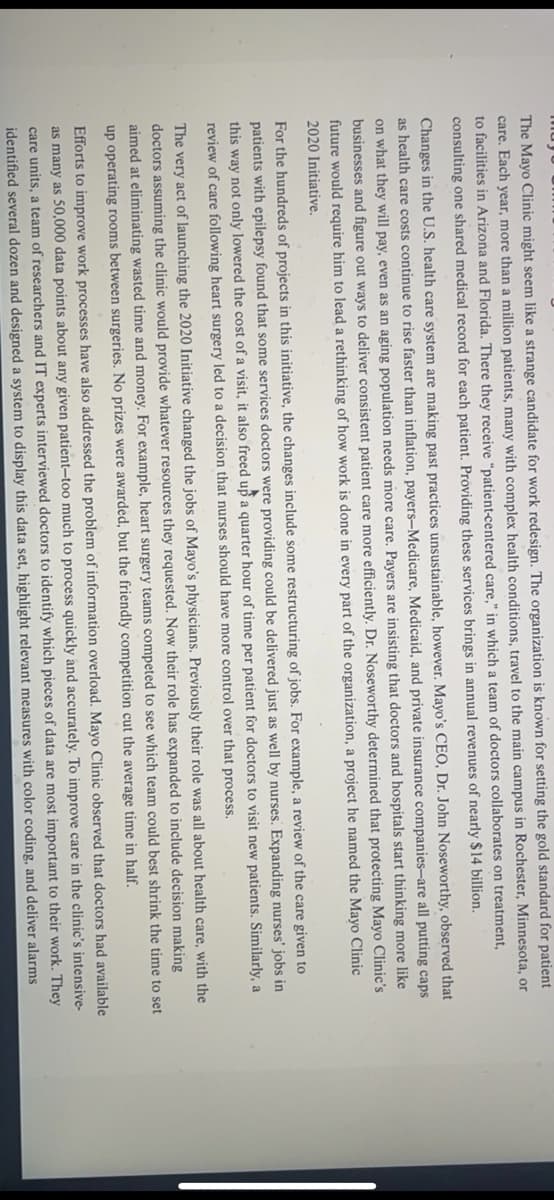What responsibilities were added to the jobs of doctors and nurses at Mayo Clinic? What impact do you think those changes had on the motivational aspect of the work?
What responsibilities were added to the jobs of doctors and nurses at Mayo Clinic? What impact do you think those changes had on the motivational aspect of the work?
Chapter1: Taking Risks And Making Profits Within The Dynamic Business Environment
Section: Chapter Questions
Problem 1CE
Related questions
Question
What responsibilities were added to the jobs of doctors and nurses at Mayo Clinic? What impact do you think those changes had on the motivational aspect of the work?

Transcribed Image Text:The Mayo Clinic might seem like a strange candidate for work redesign. The organization is known for setting the gold standard for patient
care. Each year, more than a million patients, many with complex health conditions, travel to the main campus in Rochester, Minnesota, or
to facilities in Arizona and Florida. There they receive "patient-centered care," in which a team of doctors collaborates on treatment,
consulting one shared medical record for each patient. Próviding these services brings in annual revenues of nearly $14 billion.
Changes in the U.S. health care system are making past practices unsustainable, however. Mayo's CEO, Dr. John Noseworthy, observed that
as health care costs continue to rise faster than inflation, payers-Medicare, Medicaid, and private insurance companies-are all putting caps
on what they will pay, even as an aging population needs more care. Payers are insisting that doctors and hospitals start thinking more like
businesses and figure out ways to deliver consistent patient care more efficiently. Dr. Noseworthy determined that protecting Mayo Clinic's
future would require him to lead a rethinking of how work is done in every part of the organization, a project he named the Mayo Clinic
2020 Initiative.
For the hundreds of projects in this initiative, the changes include some restructuring of jobs. For example, a review of the care given to
patients with epilepsy found that some services doctors were providing could be delivered just as well by nurses. Expanding nurses' jobs in
this way not only lowered the cost of a visit, it also freed up a quarter hour of time per patient for doctors to visit new patients. Similarly, a
review of care following heart surgery led to a decision that nurses should have more control over that process.
The very act of launching the 2020 Initiative changed the jobs of Mayo's physicians. Previously their role was all about health care, with the
doctors assuming the clinic would provide whatever resources they requested. Now their role has expanded to include decision making
aimed at eliminating wasted time and money. For example, heart surgery teams competed to see which team could best shrink the time to set
up operating rooms between surgeries. No prizes were awarded, but the friendly competition cut the average time in half.
Efforts to improve work processes have also addressed the problem of information overload. Mayo Clinic observed that doctors had available
as many as 50,000 data points about any given patient–too much to process quickly and accurately. To improve care in the clinic's intensive-
care units, a team of researchers and IT experts interviewed doctors to identify which pieces of data are most important to their work. They
identified several dozen and designed a system to display this data set, highlight relevant measures with color coding, and deliver alarms
Expert Solution
This question has been solved!
Explore an expertly crafted, step-by-step solution for a thorough understanding of key concepts.
This is a popular solution!
Trending now
This is a popular solution!
Step by step
Solved in 2 steps

Recommended textbooks for you

Understanding Business
Management
ISBN:
9781259929434
Author:
William Nickels
Publisher:
McGraw-Hill Education

Management (14th Edition)
Management
ISBN:
9780134527604
Author:
Stephen P. Robbins, Mary A. Coulter
Publisher:
PEARSON

Spreadsheet Modeling & Decision Analysis: A Pract…
Management
ISBN:
9781305947412
Author:
Cliff Ragsdale
Publisher:
Cengage Learning

Understanding Business
Management
ISBN:
9781259929434
Author:
William Nickels
Publisher:
McGraw-Hill Education

Management (14th Edition)
Management
ISBN:
9780134527604
Author:
Stephen P. Robbins, Mary A. Coulter
Publisher:
PEARSON

Spreadsheet Modeling & Decision Analysis: A Pract…
Management
ISBN:
9781305947412
Author:
Cliff Ragsdale
Publisher:
Cengage Learning

Management Information Systems: Managing The Digi…
Management
ISBN:
9780135191798
Author:
Kenneth C. Laudon, Jane P. Laudon
Publisher:
PEARSON

Business Essentials (12th Edition) (What's New in…
Management
ISBN:
9780134728391
Author:
Ronald J. Ebert, Ricky W. Griffin
Publisher:
PEARSON

Fundamentals of Management (10th Edition)
Management
ISBN:
9780134237473
Author:
Stephen P. Robbins, Mary A. Coulter, David A. De Cenzo
Publisher:
PEARSON